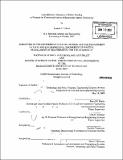| dc.contributor.advisor | David H. Marks and John D. Sterman. | en_US |
| dc.contributor.author | Culver, Lauren C. (Lauren Claire) | en_US |
| dc.contributor.other | Massachusetts Institute of Technology. Dept. of Civil and Environmental Engineering. | en_US |
| dc.date.accessioned | 2010-02-09T16:57:27Z | |
| dc.date.available | 2010-02-09T16:57:27Z | |
| dc.date.copyright | 2009 | en_US |
| dc.date.issued | 2009 | en_US |
| dc.identifier.uri | http://hdl.handle.net/1721.1/51656 | |
| dc.description | Thesis (S.M. in Technology and Policy)--Massachusetts Institute of Technology, Engineering Systems Division, Technology and Policy Program; and, (S.M.)--Massachusetts Institute of Technology, Dept. of Civil and Environmental Engineering, 2009. | en_US |
| dc.description | Includes bibliographical references (p. 148-153). | en_US |
| dc.description.abstract | The need for new Renewable Energy Technologies (RETs) is growing with the challenge of providing affordable electricity under increasing environmental and public health constraints while promoting energy security and improved energy access. Governments have chosen to intervene in the commercialization process to overcome market failures that distort private investment in new technologies to ensure the provision of these technologies. Both technology-push and demand-pull policies are necessary to accelerate commercialization of renewable energy technologies, but the optimal balance of these strategies is not understood. This thesis investigates the most cost-effective allocation of public funding, provided through a portfolio of commercialization policies, to ensure technologies bridge the valley of death. Case studies of photovoltaic technology promotion in the United States, Germany, and Japan provide examples of commercialization policy portfolios with varied results. Distilling the key funding flows and the resulting technology, product, and market development from the historical data provides a basis for a system dynamics model that simulates a firm commercializing a single technology from research and development through deployment. Different policy portfolios are tested to determine the most cost-effective distribution of commercialization support. The Japanese example suggests providing balanced support throughout research and development, demonstration, and deployment is more cost-effective than the either the US research-focused approach or the German market stimulation strategy. | en_US |
| dc.description.abstract | (cont.) Similarly, the simulation model shows that providing funding through all phases of commercialization is more cost-effective than an unbalanced strategy that relies predominately on technology-push or market-pull strategies. | en_US |
| dc.description.statementofresponsibility | by Lauren C. Culver. | en_US |
| dc.format.extent | 153 p. | en_US |
| dc.language.iso | eng | en_US |
| dc.publisher | Massachusetts Institute of Technology | en_US |
| dc.rights | M.I.T. theses are protected by
copyright. They may be viewed from this source for any purpose, but
reproduction or distribution in any format is prohibited without written
permission. See provided URL for inquiries about permission. | en_US |
| dc.rights.uri | http://dspace.mit.edu/handle/1721.1/7582 | en_US |
| dc.subject | Engineering Systems Division. | en_US |
| dc.subject | Technology and Policy Program. | en_US |
| dc.subject | Civil and Environmental Engineering. | en_US |
| dc.title | Cost-effective allocation of public funding to promote the commercialization of renewable energy technology | en_US |
| dc.type | Thesis | en_US |
| dc.description.degree | S.M. | en_US |
| dc.description.degree | S.M.in Technology and Policy | en_US |
| dc.contributor.department | Massachusetts Institute of Technology. Department of Civil and Environmental Engineering | |
| dc.contributor.department | Massachusetts Institute of Technology. Engineering Systems Division | |
| dc.contributor.department | Technology and Policy Program | |
| dc.identifier.oclc | 501810379 | en_US |
